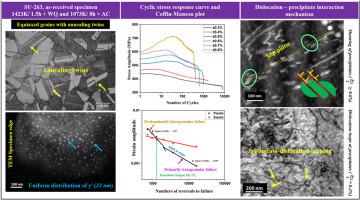Effect of strain amplitude on the low cycle fatigue behavior and deformation mechanisms in alloy SU-263 at elevated temperature
IF 6.1
2区 材料科学
Q1 MATERIALS SCIENCE, MULTIDISCIPLINARY
引用次数: 0
Abstract
The past studies in the low cycle fatigue (LCF) behavior of a γ′ strengthened nickel-based superalloy SU-263 were restricted to a maximum temperature of 923 K, though their service conditions far exceed this limit. In the present work, the LCF behavior of SU-263 is investigated at 1023 K with strain amplitude varying from ± 0.3% to ± 0.8% at 1023 K. During fatigue, the alloy displayed initial cyclic hardening followed by softening. The fatigue life decreased drastically with increasing strain amplitude. The alloy depicted gradual initial hardening at low strain amplitudes and sharp initial hardening at higher strain amplitudes, along with extensive softening until fracture. Significant increases in slip band density, stacking faults, dislocation network formation, and dislocation-dislocation and dislocation-precipitate interactions were identified as the deformation mechanisms responsible for cyclic hardening. In contrast, dislocation annihilation and shearing of γ′ precipitates were found to control cyclic softening. Dislocation-precipitate interactions were associated with looping at low strain amplitudes, while precipitate shearing occurred at high strain amplitudes. The alloy exhibited a tendency bilinear strain-life behavior in the Coffin-Manson plot with the corresponding shift in the fracture mode at ± 0.5% strain amplitude. At strain amplitudes below ± 0.5%, the alloy showed a mixed mode of failure, predominantly transgranular in nature, while at high strain amplitudes, the failure becomes predominantly intergranular.

应变振幅对高温下 SU-263 合金低循环疲劳行为和变形机制的影响
过去对γ′强化镍基超合金 SU-263 低循环疲劳(LCF)行为的研究仅限于 923 K 的最高温度,尽管其使用条件远远超出了这一限制。在本研究中,我们研究了 SU-263 在 1023 K 下的 LCF 行为,其应变振幅在 1023 K 时为 ± 0.3% 至 ± 0.8%。疲劳寿命随着应变振幅的增加而急剧下降。该合金在低应变幅时表现出渐进的初始硬化,而在高应变幅时则表现出急剧的初始硬化,并伴随着广泛的软化直至断裂。滑移带密度的显著增加、堆叠断层、位错网络的形成以及位错-异位和位错-沉淀物之间的相互作用被认为是导致循环硬化的变形机制。相反,差排湮灭和γ′析出物的剪切则控制着循环软化。差排与析出物之间的相互作用与低应变振幅下的循环有关,而析出物的剪切则发生在高应变振幅下。在 Coffin-Manson 图中,合金表现出双线应变-寿命行为趋势,断裂模式在 ± 0.5% 应变振幅时发生相应转变。应变振幅低于 ± 0.5%时,合金显示出混合的破坏模式,主要是横晶破坏,而在高应变振幅下,主要是晶间破坏。
本文章由计算机程序翻译,如有差异,请以英文原文为准。
求助全文
约1分钟内获得全文
求助全文
来源期刊

Materials Science and Engineering: A
工程技术-材料科学:综合
CiteScore
11.50
自引率
15.60%
发文量
1811
审稿时长
31 days
期刊介绍:
Materials Science and Engineering A provides an international medium for the publication of theoretical and experimental studies related to the load-bearing capacity of materials as influenced by their basic properties, processing history, microstructure and operating environment. Appropriate submissions to Materials Science and Engineering A should include scientific and/or engineering factors which affect the microstructure - strength relationships of materials and report the changes to mechanical behavior.
 求助内容:
求助内容: 应助结果提醒方式:
应助结果提醒方式:


